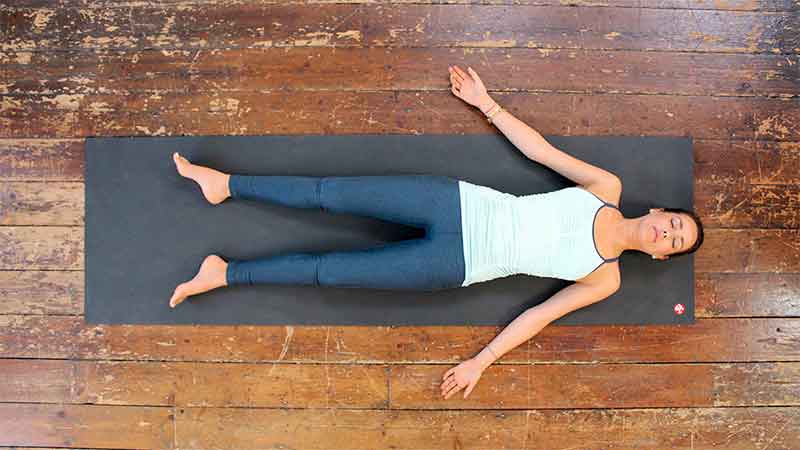
Reducing Muscle Tightness in People with Centralized Pain
 A healthy muscle is an elastic muscle. A healthy elastic muscle has a healthy stretch reflex system. When people with central sensitivity are exposed to environmental stress (too much sound, light, touch, smell, etc.) their bodies release stress hormones called norepinephrine, adrenaline, and cortisol.
A healthy muscle is an elastic muscle. A healthy elastic muscle has a healthy stretch reflex system. When people with central sensitivity are exposed to environmental stress (too much sound, light, touch, smell, etc.) their bodies release stress hormones called norepinephrine, adrenaline, and cortisol.
Adrenaline along with norepinephrine are what make you feel agitated, on edge, tense, like you’re about to jump out of your skin, or like you have a whole bunch of useless energy built up inside of you and like your about to explode or implode because of it.
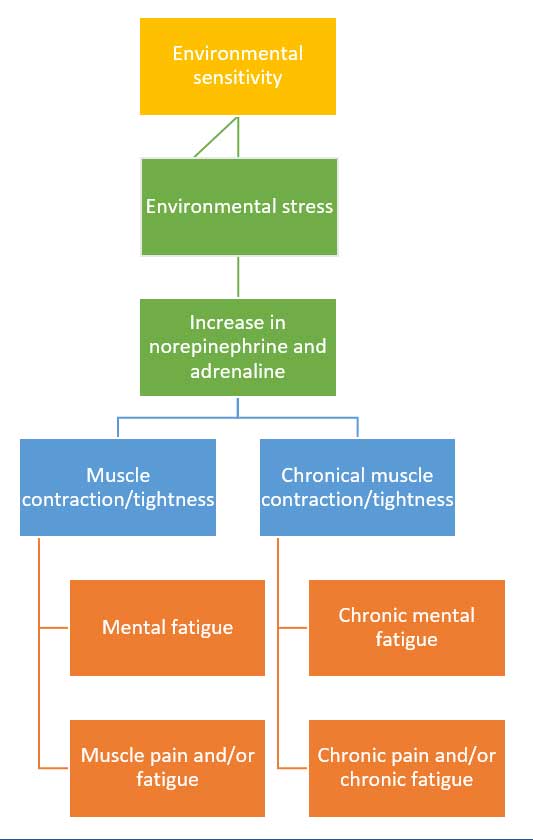 The more stressed you become, the more stress hormones are released, and the faster and shorter you breathe.
The more stressed you become, the more stress hormones are released, and the faster and shorter you breathe.
Because some people with central sensitivity are always stressed because they are sensitive even to the most relaxing environments, this leads quickly to chronic muscle contraction and tightness.
For those less sensitive, it can take years for this tightness to become chronic, which means they are always tight, even when relaxing.
When your muscles are tight all of the time, this can lead to either muscle weakness, muscle pain, or both.
Typically, chronic muscle weakness comes first, then in time, chronic muscle pain follows.
This also leads to chronic mental fatigue and emotional control issues along with concentration and attentional issues.
Because there is no way to cure the sensitivity, one can reduce environmental stress by:
- Staying within environments that are the least stressful to them, or
- Shortening the time they are in stressful environments.
This reduces the amount of stress hormones released, and in turn reduces muscle tightness. However, severe chronic muscle tightness typically does not respond well to relaxation techniques, stretching, or reducing environmental exposure.
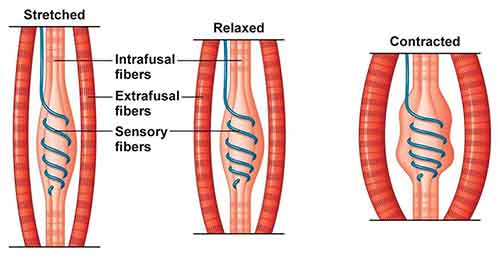 This is because of the neurodynamics of our muscles. Again, a healthy muscle is an elastic one. However, years of muscle tension lead the muscles to become less elastic and shorter in size. To make an unhealthy muscle healthy again, you have to:
This is because of the neurodynamics of our muscles. Again, a healthy muscle is an elastic one. However, years of muscle tension lead the muscles to become less elastic and shorter in size. To make an unhealthy muscle healthy again, you have to:
- Regain muscle elasticity
- Regain muscle length
In doing so, stretch reflexes can be properly activated. Unhealthy muscles in time begin to not only shorten but collapse often overworking the lower back, which is a major source of pain for most with central sensitivity.
So, as a measure, the more your lower back hurts, the more unhealthy your muscles may be.
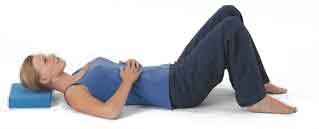
Semi-Supine Method
Again, basic relaxation techniques do not work well at this state, but muscle re-education does, such as mechanical support like sitting with a supported back (back support for chairs), laying in the semi-supine method, or for those with a whole lot of muscle fatigue, the yoga posture “corpse pose” method is probably more for you.
These methods help re-educate your muscles in a passive and gentle way and reduce some tension right away, and over time as you use the methods.

Corpse Pose Method
I recommend doing the method or methods that work best for you once a day and how long depends on how long you can handle the pain of laying on a hard flat surface (or in the case of using a back support device, lying against a firm support), but shoot for at least 10 minutes.
Yes, the floor, table, etc., must be hard, and it must be flat for the semi-supine and corpse pose. For those with little pain use a hard wood or vinyl floor. For those with a lot of pain, lay on carpeting.
For the semi-supine position you will need a thin pillow to help support your head. You can also use a thin pillow, foam or otherwise, for the copse pose, but only if you really need it.
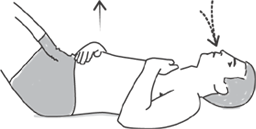 For those with scoliosis, like myself, these methods may replace you chiropractor. When laying down (semi-supine or corpse pose) make sure you aren’t stress-breathing. Stress breathing is when your chest rises and falls instead of your abdomen. If you’re not sure if you are chest or abdomen breathing:
For those with scoliosis, like myself, these methods may replace you chiropractor. When laying down (semi-supine or corpse pose) make sure you aren’t stress-breathing. Stress breathing is when your chest rises and falls instead of your abdomen. If you’re not sure if you are chest or abdomen breathing:
- Place one hand on your chest
- Place your other hand on your abdomen
- Breath naturally.
Make the breathing correction if needed, and take slow deep breaths. Keep in mind though, you wont feel relaxed doing these methods. Instead, you should feel a gentle stretch all over your body, especially in your back. The best time to end a session is when you no longer feel the stretch or just barely. Upon rising you should feel some marked relief in pain and tension.
Continue doing this daily for accumulative relief over time.
Sources
- Dimon, T (2015). Neurodynamics: The Art of Mindfulness in Action. North Atlantic Books, 1st Ed.
- Klein, S (2013). Adrenaline, Cortisol, Norepinephrine: The Three Major Stress Hormones, Explained. (www.huffingtonpost.com)

